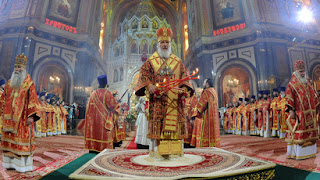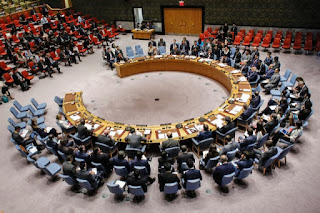The Glorious “Holy Fire” Miracle of Easter
The Glorious
“Holy Fire” Miracle of Easter
By E. Stanley Ukeni
As I write this post thousands
of Christian faithful—from diverse denominations, are gathered at the Church of
the Holy Sepulchre in Jerusalem, Israel, where the Tomb of Christ is located. They
are there to witness the miracle of the Holy Fire that heralds the resurrection
of Jesus Christ from the dead.
Eastern Orthodox Christians,
particularly, believe that on the eve of the resurrection, Holy Fire
spontaneously emanates inside the Edicule of the Church of the Holy Sepulchre—the
small chamber marking the location of the Christ’s tomb. The divine fire is
believed to represent the triumph of the divine nature—the spirit-man, over the
flesh, our physical nature. I am convinced that this mystic-flame re-energizes
the resurrection power of the spirit-nature of humankind.
Since the early hours of the
morning, crowds of worshipers, numbering in the thousands, have been converging
at the ancient holy site—where Christians believe that Jesus Christ was crucified,
buried and resurrected, but only the earlier arrivals at the Church of the Holy
Sepulchre will be able to enter and witness the event.
During the annual religious
ceremony, which dates back at least 1,200 years, a select group of top Eastern Orthodox
Christian clerics would enter the small chamber marking the site of Jesus’ tomb,
called the Edicule. After a little while, they then emerge from the chamber with
two votive beewax candles lit by ‘holy fire’ that miraculously kindled inside
the chamber.
I consider the mystic flame as
a message from heaven, symbolizing that the light of Christ’s love remains with
us, even during dark time, when the light of hope seems extinguished by terror
and evil.
Here is how the sacred ceremony
typically unfolds. Prior to the commencement of the sacred ritual, the Edicule
is thoroughly searched by pious attendants to ensure that there are no lit
flames, or any physical means of creating fire, stashed inside the hallowed
chamber.
At about 1:00pm, the Patriarch
of the Christian Orthodox Church would enter the Edicule—after circling the
sacred structure three times, followed by monks and priests, as they
prayerfully implore God to manifest the holy fire of divine resurrection. He is
followed into the chamber by the Patriarch of the Armenian Orthodox Church. The
doors to the chamber are then symbolically sealed with a 2-3 kilo block of beewax—an
allegorical depiction of how Christ’s tomb was sealed and then guarded by Roman
soldiers.
The mystery of how the holy
fire is miraculously kindled is a closely guarded secret. However, according to
Orthodox Christian lore, it is believed that mystical fire spontaneously kindles
on the sacred stone-slab on which the body of Jesus Christ laid, in the tomb,
after His crucifixion. The mystic flame is said to be cool to touch initially,
before turning scalding hot.
According to Orthodox
tradition, the Patriarch of the Christian Orthodox Church is said to kneel
before the Holy Fire and then lights the candles he brought with him into the
Edicule from the kindled Holy Fire on the sacred stone-slab.
After the candles have been
lit, Patriarch Orthodox Church—still inside the Edicule, continues the sacred
ritual by taking the votive candles that have been miraculously lit by the Lord
and distributes the Holy Fire.
He passes the sacred flame out
of the Chapel of the Angels—the vestibule of the tomb,
through two side
openings. The thousands of expectant pilgrims greet the appearance of the Holy
Fire with shouts of elation and revelry.
The worshipers then share the mystic fire
among themselves. Before long, thousands of candles are lit-up inside the
Church, in a spectacular display of faith and devotion. The candles are then extinguished
a few minutes afterwards, as tradition dictates.
It is well understood by the
faithful that the tapers must be lit with the sacred flame, but then the fire
extinguished soon after—with the candle preserved as a testimony to one’s
participation in the sacred ceremony. While the candle is still alight, the faithful
pass their hands through the flame, and then touch their faces with their hand—in
a symbolic transference of the divine grace and power infused in the Holy Fire
to themselves.
Accounts detailed on the
website, holyfire.org, traces the first manifestation of the Holy Fire back to
the day of the resurrection of Christ. The site cites Church fathers, Gregory
of Nyssa and John Damascene, who themselves went to Jerusalem. Gregory of Nyssa,
in his Second Homily on the Resurrection of Christ, writes: ‘Peter saw with his own eyes, but also
through the elevation of the apostolic spirit, that the Tomb was illuminated
even though it was night—he saw it with his senses and spiritually’. John
Damascene, in his liturgical hymns, scribes: ‘Peter, having rapidly approached the Tomb and having seen the light
inside the sepulcher was frightened’.
My research reveals that the
first known account of the miracle of Holy Fire dates all the way back to the
Carolingian period, around 810 A.D., the Latin monk Bernard, in his writings,
describes how, ‘On Holy Saturday, the eve
of Easter, at the morning service in the church in the Temple of the Tomb of
the Lord, the Patriarch transmits the fire to the Bishop and then to all the
people, so that each can light this fire in his home’.
The miracle of the Holy Fire
marks the resurrection of the Christ. Let our hearts be gladdened for it is
true that Christ had indeed risen. He has truly risen—and with Him is our hope
in righteousness. Happy Easter to all...be blessed!
Authored
by E. Stanley Ukeni, © 2017. All Rights Reserved. This material and other articles or
stories posted on this blog site may not be reproduced, published, broadcast,
rewritten or redistributed, in whole or in part, without prior expressed
written permission from the author, E. Stanley Ukeni.
You
are invited to follow E. Stanley Ukeni on twitter at; @EzStan . I invite you to
equally follow me on google+ Be sure to subscribe to my blog.
Photo Credits: Wikipedia; rt.com







Comments
Post a Comment